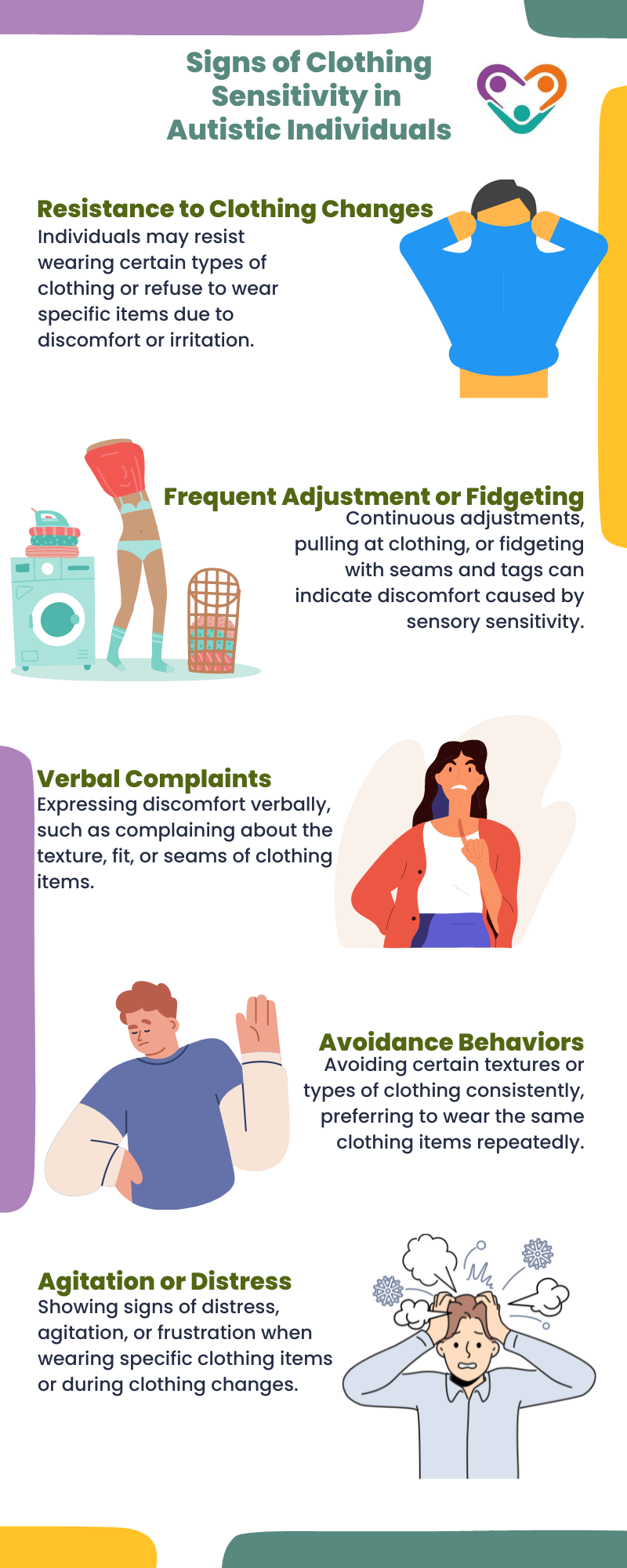Sensory sensitivity is a common trait among people with autism which often affects their experience with clothing. This sensitivity can lead to significant discomfort and distress, making it challenging to dress comfortably for daily activities.
Managing clothing issues in individuals with autism requires insight into the sensory sensitivities involved and practical strategies to alleviate discomfort.

Sensory Sensitivity in Autism
Sensory sensitivity in autism can manifest in various ways, including hypersensitivity (over-responsiveness) or hyposensitivity (under-responsiveness) to sensory stimuli such as touch, sound, sight, taste, and smell.
When it comes to clothing, tactile sensitivity – sensitivity to touch and texture – is particularly relevant. Autistic individuals may experience clothing as irritating, uncomfortable, or even painful due to heightened sensitivity to fabrics, seams, tags, and tightness.
Research indicates that sensory processing differences in individuals with autism can lead to altered perceptions of touch and discomfort with certain textures. According to a study, sensory processing issues affect daily life activities, including clothing choices and preferences.
Recognizing signs of clothing sensitivity in individuals with autism is crucial for understanding their needs and providing appropriate support. Sensory sensitivities related to clothing can vary widely among autistic individuals but often manifest in observable behaviors and reactions.
Here are common signs that indicate clothing sensitivity in autism:

By recognizing signs of clothing sensitivity, caregivers and support professionals can enhance comfort and improve daily living for individuals on the autism spectrum.
Practical Strategies for Managing Clothing Sensitivity
Understanding and addressing clothing sensitivity in autism requires a tailored approach that respects individual preferences and sensory needs. Here are some practical yet effective strategies that parents and caregivers can follow:
Fabric Choice
Understanding the preferred fabric textures for individuals with autism can significantly improve comfort. Opting for soft, breathable materials like organic cotton or moisture-wicking fabrics can reduce sensory discomfort. Studies suggest that accommodating fabric preferences can enhance sensory experiences and reduce distress.
Seams and Tags
Removing tags or opting for tagless clothing can eliminate a common source of irritation. Choosing clothing with flat seams or seamless designs can also minimize discomfort caused by rough seams.

Clothing Fit
Allowing for looser-fitting clothing can provide more freedom of movement and reduce sensory overload. Elastic-free waistbands and adjustable closures can offer comfort without unnecessary pressure.
Temperature Regulation
Layering clothing options allows for flexibility in adapting to temperature changes throughout the day. Lightweight layers that can be easily adjusted or removed provide comfort and prevent overheating or discomfort.
Preparing for Transitions
For individuals who struggle with changes in routine or sensory sensitivities related to clothing, preparing clothing choices ahead of time can ease transitions. Offering choices within acceptable parameters can empower autonomy while ensuring comfort.
Interventions and Support
Occupational therapy (OT) plays a crucial role in addressing sensory sensitivities associated with clothing. OT interventions may include sensory integration therapy, desensitization techniques, and sensory-based strategies to improve tolerance and comfort with clothing choices.
The Key Takeaway
Managing clothing sensitivity in individuals with autism involves recognizing and accommodating sensory preferences and sensitivities.
By understanding the unique sensory experiences of individuals with autism and implementing practical strategies such as fabric choice, seam management, and temperature regulation, caregivers and support professionals can enhance comfort and improve daily living for autistic individuals. Golden Care offers comprehensive ABA services in New Jersey, Georgia, Indiana, and New York to support families in managing sensory issues and other challenges associated with autism. Contact us today to learn more or book a consultation to tailor support to your loved one’s needs.
Sources:
https://www.autismparentingmagazine.com/autism-child-hypersensitive-to-clothing
https://www.autismhorizon.com/autism-clothing-issues
https://learningforapurpose.com/31-sensory-strategies-with-dressing-for-children-with-autism
https://autism.fratnow.com/blog/clothing-sensitivity-in-autism



